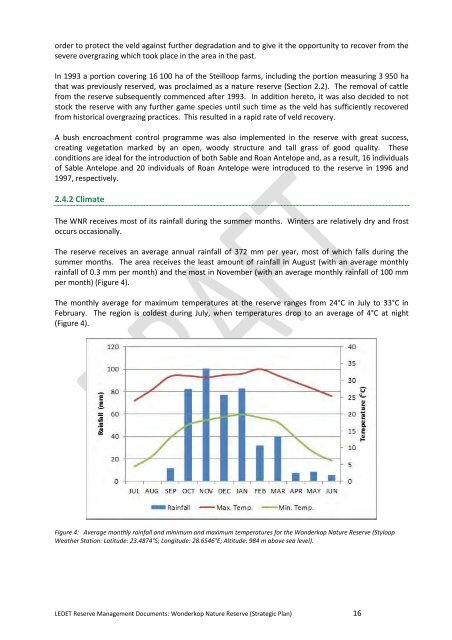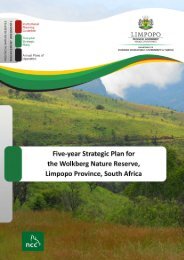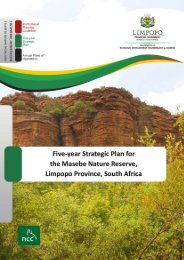Guiding principles for reserve management - NCC Environmental ...
Guiding principles for reserve management - NCC Environmental ...
Guiding principles for reserve management - NCC Environmental ...
You also want an ePaper? Increase the reach of your titles
YUMPU automatically turns print PDFs into web optimized ePapers that Google loves.
order to protect the veld against further degradation and to give it the opportunity to recover from thesevere overgrazing which took place in the area in the past.In 1993 a portion covering 16 100 ha of the Steilloop farms, including the portion measuring 3 950 hathat was previously <strong>reserve</strong>d, was proclaimed as a nature <strong>reserve</strong> (Section 2.2). The removal of cattlefrom the <strong>reserve</strong> subsequently commenced after 1993. In addition hereto, it was also decided to notstock the <strong>reserve</strong> with any further game species until such time as the veld has sufficiently recoveredfrom historical overgrazing practices. This resulted in a rapid rate of veld recovery.A bush encroachment control programme was also implemented in the <strong>reserve</strong> with great success,creating vegetation marked by an open, woody structure and tall grass of good quality. Theseconditions are ideal <strong>for</strong> the introduction of both Sable and Roan Antelope and, as a result, 16 individualsof Sable Antelope and 20 individuals of Roan Antelope were introduced to the <strong>reserve</strong> in 1996 and1997, respectively.2.4.2 ClimateThe WNR receives most of its rainfall during the summer months. Winters are relatively dry and frostoccurs occasionally.The <strong>reserve</strong> receives an average annual rainfall of 372 mm per year, most of which falls during thesummer months. The area receives the least amount of rainfall in August (with an average monthlyrainfall of 0.3 mm per month) and the most in November (with an average monthly rainfall of 100 mmper month) (Figure 4).The monthly average <strong>for</strong> maximum temperatures at the <strong>reserve</strong> ranges from 24°C in July to 33°C inFebruary. The region is coldest during July, when temperatures drop to an average of 4°C at night(Figure 4).Figure 4: Average monthly rainfall and minimum and maximum temperatures <strong>for</strong> the Wonderkop Nature Reserve (StyloopWeather Station: Latitude: 23.4874°S; Longitude: 28.6546°E; Altitude: 984 m above sea level).LEDET Reserve Management Documents: Wonderkop Nature Reserve (Strategic Plan) 16
















